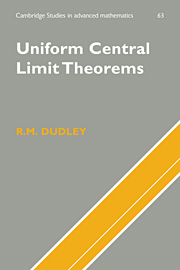Book contents
- Frontmatter
- Contents
- Preface
- 1 Introduction: Donsker's Theorem, Metric Entropy, and Inequalities
- 2 Gaussian Measures and Processes; Sample Continuity
- 3 Foundations of Uniform Central Limit Theorems: Donsker Classes
- 4 Vapnik-Červonenkis Combinatorics
- 5 Measurability
- 6 Limit Theorems for Vapnik-Červonenkis and Related Classes
- 7 Metric Entropy, with Inclusion and Bracketing
- 8 Approximation of Functions and Sets
- 9 Sums in General Banach Spaces and Invariance Principles
- 10 Universal and Uniform Central Limit Theorems
- 11 The Two-Sample Case, the Bootstrap, and Confidence Sets
- 12 Classes of Sets or Functions Too Large for Central Limit Theorems
- Appendix A Differentiating under an Integral Sign
- Appendix B Multinomial Distributions
- Appendix C Measures on Nonseparable Metric Spaces
- Appendix D An Extension of Lusin's Theorem
- Appendix E Bochner and Pettis Integrals
- Appendix F Nonexistence of Types of Linear Forms on Some Spaces
- Appendix G Separation of Analytic Sets; Borel Injections
- Appendix H Young-Orlicz Spaces
- Appendix I Modifications and Versions of Isonormal Processes
- Subject Index
- Author Index
- Index of Notation
9 - Sums in General Banach Spaces and Invariance Principles
Published online by Cambridge University Press: 20 May 2010
- Frontmatter
- Contents
- Preface
- 1 Introduction: Donsker's Theorem, Metric Entropy, and Inequalities
- 2 Gaussian Measures and Processes; Sample Continuity
- 3 Foundations of Uniform Central Limit Theorems: Donsker Classes
- 4 Vapnik-Červonenkis Combinatorics
- 5 Measurability
- 6 Limit Theorems for Vapnik-Červonenkis and Related Classes
- 7 Metric Entropy, with Inclusion and Bracketing
- 8 Approximation of Functions and Sets
- 9 Sums in General Banach Spaces and Invariance Principles
- 10 Universal and Uniform Central Limit Theorems
- 11 The Two-Sample Case, the Bootstrap, and Confidence Sets
- 12 Classes of Sets or Functions Too Large for Central Limit Theorems
- Appendix A Differentiating under an Integral Sign
- Appendix B Multinomial Distributions
- Appendix C Measures on Nonseparable Metric Spaces
- Appendix D An Extension of Lusin's Theorem
- Appendix E Bochner and Pettis Integrals
- Appendix F Nonexistence of Types of Linear Forms on Some Spaces
- Appendix G Separation of Analytic Sets; Borel Injections
- Appendix H Young-Orlicz Spaces
- Appendix I Modifications and Versions of Isonormal Processes
- Subject Index
- Author Index
- Index of Notation
Summary
Let (S, ∥·∥) be a Banach space (in general nonseparable). A subset of the unit ball {f ∈ S′ : ∥f∥′ ≤ 1} is called a norming subset if and only if for all s ∈ S. The whole unit ball in S is always a norming subset by the Hahn-Banach theorem (RAP, Corollary 6.1.5).
Conversely, given any set, let be the set of all bounded real functions on, with the supremum norm
Then the natural map f ↦ (s ↦ s(f)) takes one-to-one onto a norming subset of S′.
So, limit theorems for empirical measures, uniformly over a class of functions, can be viewed as limit theorems in a Banach space S with norm Conversely, limit theorems in a general Banach space S with norm ∥ · ∥ can be viewed as limit theorems for empirical measures on S, uniformly over a class of functions, such as the unit ball of S′, since for f ∈ S′ and x1, …, xn ∈ S,
Suppose that Xj are i.i.d. real random variables with mean 0 and variance 1. Let One form of “invariance principle” will say that on some probability space, there exist such Xj and also i.i.d. N(0, 1) variables Y1, Y2, …, with such that as n → ∞ in probability. Since Tn/n½ also has a N(0, 1) distribution for each n, the invariance principle implies that Sn/n½ is close to Tn/n½, which implies the central limit theorem. Although it is not as obvious, central limit theorems generally imply invariance principles.
- Type
- Chapter
- Information
- Uniform Central Limit Theorems , pp. 285 - 313Publisher: Cambridge University PressPrint publication year: 1999

